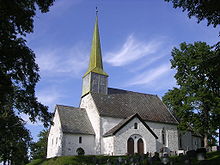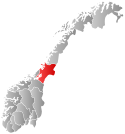|
Skogn Municipality
Skogn is a former municipality in the old Nord-Trøndelag county, Norway. The 340-square-kilometre (130 sq mi) municipality existed from 1838 until its dissolution in 1962. The municipality was located to the south and southwest of the town of Levanger in what is now Levanger Municipality in Trøndelag county. The administrative centre was the village of Skogn.[6] Prior to its dissolution in 1962, the 340-square-kilometre (130 sq mi) municipality was the 261st largest by area out of the 731 municipalities in Norway. Skogn Municipality was the 176th most populous municipality in Norway with a population of about 4,779. The municipality's population density was 14.1 inhabitants per square kilometre (37/sq mi) and its population had increased by 8.1% over the previous 10-year period.[7][8] General information   The prestegjeld of Skogn was established as a municipality on 1 January 1838 (see formannskapsdistrikt law). On 28 November 1874, a royal resolution moved two uninhabited parts of Skogn Municipality to the neighboring Levanger landsogn.[9] During the 1960s, there were many municipal mergers across Norway due to the work of the Schei Committee. On 1 January 1962, the town of Levanger (population: 1,669) was merged with the neighboring Frol Municipality (population: 3,774), Åsen Municipality (population: 1,939), and Skogn Municipality (population: 4,756) to form a new, larger Levanger Municipality.[9] NameThe municipality (originally the parish) is named after the old name for the area (Old Norse: Skaun). The name comes from the word skaun which means "beautiful" or "lovely" (similar to the German word schön). ChurchesThe Church of Norway had one parish (sokn) within Skogn Municipality. At the time of the municipal dissolution, it was part of the Skogn prestegjeld and the Sør-Innherad prosti (deanery) in the Diocese of Nidaros.[8]
GeographySkogn Municipality was located to the south of the town of Levanger. It was bordered by Frosta Municipality and Åsen Municipality to the west, Hegra Municipality to the south, Verdal Municipality to the east, and Frol Municipality to the northeast. The highest point in the municipality was the 735.35-metre (2,412.6 ft) tall mountain Hårskallen, located on the border with Skogn Municipality.[1] GovernmentWhile it existed, Skogn Municipality was responsible for primary education (through 10th grade), outpatient health services, senior citizen services, welfare and other social services, zoning, economic development, and municipal roads and utilities. The municipality was governed by a municipal council of directly elected representatives. The mayor was indirectly elected by a vote of the municipal council.[10] The municipality was under the jurisdiction of the Frostating Court of Appeal. Municipal councilThe municipal council (Herredsstyre) of Skogn was made up of 25 representatives that were elected to four year terms. The tables below show the historical composition of the council by political party.
MayorsThe mayor (Norwegian: ordfører) of Skogn was the political leader of the municipality and the chairperson of the municipal council. Here is a list of people who held this position:[17]
See alsoReferences
|
|||||||||||||||||||||||||||||||||||||||||||||||||||||||||||||||||||||||||||||||||||||||||||||||||||||||||||||||||||||||||||||||||||||||||||||||||||||||||||||||||||||||||||||||||||||||||||||||||||||



